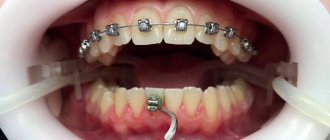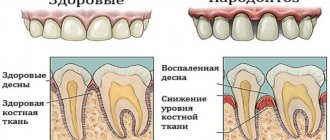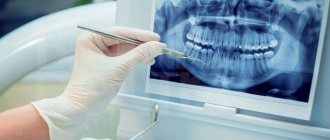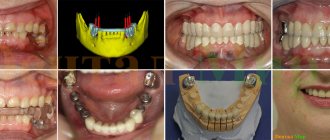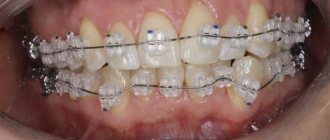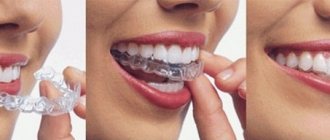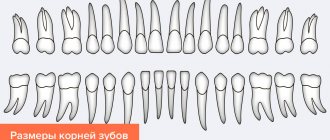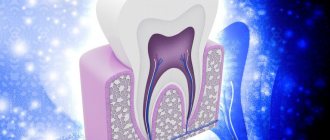Extracting, drilling, placing implants, fillings and crowns - is this all that dentists can offer today to preserve people’s ability to chew and smile?
Nowadays, in all areas of medicine, a trend towards minimally invasive treatment is developing, that is, treatment with minimal intervention in the human body. But what, dentists can offer only professional hygiene and whitening for the health and beauty of teeth, among harmless procedures? Of course not!
In addition to the hygienist, we know another dental profession that patients do not associate with toothache, and the treatment provided prevents many diseases, and not only dental ones, because everything in the human body is interconnected.
Still haven't guessed what dental specialty we're talking about?
Almighty Orthodontics
It is known that doctors tried to treat anomalies and deformations of the dental system for a very long time, and at the beginning of its development, “orthodontic treatment” was not a painless procedure. To eliminate aesthetic defects caused by incorrect positioning of teeth, doctors typically used finger pressure on the teeth, rotated them with forceps, or simply removed them.
It is believed that the term “orthodontics” was first used in 1840. It denoted “the science that has to do with correcting misaligned teeth.”
The term “Orthodontics” is derived from the Greek words orthos - straight, correct and odus, odontos - tooth.
At first, this term really lived up to its description, but over time, as knowledge accumulated and treatment methods improved, in addition to correcting the incorrect position of teeth, doctors began to engage in more complex treatment of dental anomalies and malocclusions.
This is the time to note that if a person has straight teeth, this does not mean that he has the correct bite.
Signs of correct bite
Determining the correct closure is quite simple and without professional knowledge. With a normal bite:
- facial features are proportional and harmonious;
- the upper jaw hangs slightly over the lower jaw, the upper incisors cover the lower ones by one third;
- the contact of molars and premolars is as dense as possible;
- the teeth are straight, without gaps;
- the upper canines are located symmetrically, each above the third and fourth lower teeth;
- the line of facial symmetry falls between the central incisors of both jaws.
What is correct bite?
Correct bite is the most physiological (natural) closure of teeth for a person. Doctors call this closure central occlusion.
If the jaws are developed proportionally and are in the correct relationship, then the entire human chewing apparatus works harmoniously and does not experience overload. And this is the key to long-term and problem-free functioning of the teeth and the temporomandibular joint.
There are several classifications of malocclusions, one of the most common was created by the “father of American orthodontics,” dentist Edward Engle. He identified three types of occlusion depending on how the “sixth” teeth close, calling them the “key of occlusion.”
According to Engle’s classification, the most physiological for the human dental system is the closure of teeth in class I (first). When correcting malocclusion, orthodontists try to create just such a jaw relationship.
And here is what deviations from the “norm” look like in comparison with the “standard” bite.
the most physiological closure of teeth (Class I according to Engle) in comparison with three malocclusions
II class, 1st subclass according to Engle
II class, 2nd subclass according to Engle
III class according to Engle
The videos clearly demonstrate how the relationship of teeth and jaws affects the shape of a person’s face and smile. But why pay attention to the “correct closure” of teeth if there are no obvious problems?
Myatkina Maria Gennadievna Orthodontist Work experience: 3 years
Ivanova Anastasia Vadimovna Orthodontist Work experience: 5 years
Services and prices
| Services | Price |
Distal bite
Distal bite – the upper front teeth are pushed forward in relation to the lower ones. A distinctive feature of such a bite is a discrepancy in size in the anteroposterior direction, in other words, either an overdeveloped upper jaw or an underdeveloped lower jaw.
The process of distributing the chewing load is disrupted. In this case, the back teeth will take on the load of the front teeth. In people with a distal bite, the back teeth will be more susceptible to tooth decay.
With this pathology, a person’s chin is disproportionately small, the face appears more childish and indecisive. After correcting the bite, the proportions of the face are aligned, the face acquires more correct proportions and appears more strong-willed.
Over many years, people usually adapt to life with a distal occlusion, and perhaps nothing bothers such a patient other than aesthetic inconsistency. But there comes a time when the distal bite begins to cause discomfort. Early development of periodontal diseases: periodontitis (inflammation of the gums) and periodontosis (loose teeth associated with pathological changes in the ligaments that hold the tooth in the bone and the bone itself), diseases of the temporomandibular joint, difficulties with prosthetics - these are some of the consequences of distal occlusion.
Distal bite is treated in different ways. In early childhood, removable appliances are used to restrain the growth of the upper jaw and stimulate the growth of the lower jaw. When such a device cannot be used (when jaw growth stops), then a bracket system is used. In this case, additional devices to the bracket system can be used.
Mesial bite
Mesial bite – the lower jaw protrudes forward.
Characterized by the anterior position of the lower jaw in relation to the upper. One of the hallmarks of a mesial bite is a protruding chin. Such a chin makes a young man’s face strong-willed and self-confident, but it is unlikely to beautify a girl.
The consequences of mesial occlusion, in addition to aesthetic inconsistency, are almost the same as with distal occlusion. Impaired chewing function, and as a result – the earlier development of periodontal diseases: periodontitis and periodontal disease, diseases of the temporomandibular joint, difficulties with prosthetics.
Treatment of mesial malocclusion is a very long process. The sooner a patient consults an orthodontist, the better, since jaw growth may be affected at an early age. If the upper jaw is underdeveloped, its growth must be stimulated; if the lower jaw is overdeveloped, you can try to restrain its growth. For this purpose, removable devices are used in childhood.
In adulthood, there are several treatment options for mesial malocclusion. These are orthognathic operations aimed at changing the position and size of the jaws and profile, as well as bite correction using a brace system with the possible removal of individual teeth.
Open bite
Open bite - the front or side teeth do not close together, forming a gap between them.
An open bite is a bite in which the teeth of the upper and lower jaws do not meet (do not contact). Pathology can be observed in the anterior and lateral sections; in the area of several teeth or a whole group of teeth.
The most obvious external manifestation of an open bite in the anterior region is a constantly slightly open mouth. A violation in only one of the lateral sections manifests itself in asymmetry of facial features.
In adult patients with established bad habits and formed jaws, it is necessary to use non-removable devices (braces), although it is worth recognizing that this form of pathology is one of the most difficult for orthodontists.
Deep bite
Deep bite - the incisors of the upper dentition overlap the incisors of the lower dentition by more than half, while the lower incisors do not rest on the dental cusps of the upper teeth.
Normally, the upper teeth should overlap the lower teeth by 1/3 of the length of the crown of the lower teeth. When the upper teeth overlap the lower teeth by more than half their length, then such a bite is considered deep. It can be deep not only in the front, but also in the lateral sections too.
With this type of bite, the face has insufficient height; the lower lip often turns outward, as there is not enough space for it. However, if a person tries to purse his lip, then the lips can be very thin. After treatment, the face acquires proportional dimensions, the upper lip stops turning outward. If a person purses his lips, then over time this habit goes away.
As a rule, the first object of damage in such a bite is the periodontium (the apparatus that holds the tooth in the bone); periodontal disease (loose teeth associated with pathological changes in the ligaments that hold the tooth in the bone and the bone itself), periodontitis (inflammation of the gums), and the mucous membrane The lining of the oral cavity suffers due to chronic dental trauma.
A common phenomenon with a deep bite is increased tooth wear. This in turn leads to changes in the tone of the masticatory muscles, which ultimately affects the temporomandibular joint (TMJ). Patients with a deep bite most often complain of crunching, clicking and pain in the joint. Sometimes damage to the TMJ can cause frequent headaches. There is no doubt that people with deep bites also have difficulties with prosthetics. Fixed and removable structures do not hold up well, they have to be changed frequently, which causes a lot of trouble for both the patient and the doctor.
Deep bite is often combined with other types of pathology, and most often with distal bite. Treatment of a deep bite will consist of increasing it using various devices from bite plates to a brace system.
Crossbite
Crossbite is a weak development of one side of either jaw.
Normally, all upper teeth should overlap the lower teeth in the anterior section by 1/3 of the length of the crown of the lower teeth, and in the lateral section, the outer cusps of the upper teeth should overlap the outer cusps of the lower teeth. Crossbite is a violation of this relationship of teeth in any direction. It can be unilateral or bilateral, it can be in the anterior and lateral sections.
In this malocclusion pathology, the chewing function suffers the most. Often such patients chew on one side. Those teeth that will take an active part in chewing are more susceptible to caries, and the early development of periodontal diseases (periodontal disease and periodontitis) is an indispensable companion to this form of pathology. With such uneven chewing, the temporomandibular joint (TMJ) often suffers, problems may arise when opening the mouth (crunching and restriction when opening), pain, which is often masked as a headache.
Subsequently, prosthetics with removable and non-removable structures will be very difficult for people with such pathology; fixed and removable structures do not hold up well and have to be changed frequently. Treatment of crossbite comes down to equalizing the size of the jaws, which can be achieved either with removable devices or with a brace system using additional devices to expand the jaws.
How does malocclusion affect a person?
The human body knows how to adapt, leveling out existing problems, and thereby masks them. But this kind of adaptation does not go unnoticed, so if there are problems with the bite, sooner or later they will make themselves felt.
We will give just a few of the problems that an incorrect bite may lead to in the future:
- crowded teeth make daily hygiene difficult and provoke the development of caries
- Bite problems can cause poor diction
- the atypical structure of the maxillofacial region leads to ENT diseases, respiratory dysfunction and can be the cause of the dangerous disease sleep apnea
- improper closure of teeth interferes with thorough chewing of food and contributes to the development of gastrointestinal diseases
- Uneven chewing load accelerates tooth wear and can lead to exposed tooth roots
- disorders of the temporomandibular joint can cause headaches
Moreover, an incorrect bite limits the possibilities of functional and aesthetic prosthetics. For example, before installing crowns and veneers, orthodontic treatment may be required, either as an integral part of preparation for prosthetics, or as a recommended step that will allow the doctor to provide a longer warranty period for the orthopedic structure.
We will illustrate the importance of the orthodontic stage before prosthetics and aesthetic restoration with veneers.
In this case, before prosthetics, it is necessary to create a place for installing a crown on the implant.
Installing veneers without first correcting the bite risks chipping the ceramics, which means re-prosthetics will be required. This is described in more detail in the video blog of the Star Smile company (Russian manufacturer of transparent aligners for correcting bites).
At the end of this part of the article, we want to once again emphasize that malocclusion can have an impact outside the oral cavity. Therefore, it will be difficult to establish cause-and-effect relationships on your own, without examining specialists.
To understand even better what we mean, watch the video “How malocclusion affects a person.”
Correction of distal bite
Deep bites can be corrected surgically and non-surgically. The second option involves orthodontic and orthopedic treatment. First, the lateral teeth are pushed forward, then the inclination of the incisors is leveled. If desired, the patient can resort to orthopedic treatment - installation of veneers, onlays, crowns.
With any type of treatment, a complete sanitation of the oral cavity is first carried out - all infectious processes are eliminated, caries is treated, tartar is removed, etc. If this is not done, the patient will face complications in the form of caries and periodontal disease. The dentist also explains in detail to the person the importance of home hygiene. If it is insufficient, these complications may also occur.
Treatment of deep bite in childhood
This correction can be carried out from the age of 7 years. At this age, the child develops a mixed bite, the bone tissue is still unstable, and the teeth are more susceptible to the effects of the braces system. Orthodontists also resort to installing removable plates.
It is also important to eliminate the cause of the pathology. For example, if a distal bite has formed due to the habit of thumb sucking, but it has not been eradicated, even after comprehensive treatment a relapse may occur. If the orthodontist discovers such a problem, then first of all he refers the child to a psychologist, since most often such habits are a consequence of stress.
Treatment of deep bite in adults
Mature people with this pathology have braces installed. At the same time, the position of the teeth is changed so that the chewing load is evenly distributed between them.
Reference!
With a distal bite, an overlap of the lower teeth by 1/3 would be considered a good result.
The next option is the installation of an orthopedic structure: veneers, onlays or crowns. The main disadvantage of this procedure is the likelihood of severe grinding of the teeth and injury to the pulp.
Another technique is a combination of the previous two methods. First, the teeth are orthodontically prepared, and then orthopedic restoration.
Orthognathic surgery
This treatment option is appropriate for severe cases of distal malocclusion. Surgery can reduce or increase the size of the jaw. It is also important to undergo treatment with an orthodontist before surgery. This period takes from one year to one and a half years.
The operation is performed under general anesthesia. The patient is observed in the hospital for several days, then walks with installed intermaxillary traction for another 6 weeks. After recovery, the second stage of orthodontic treatment follows, which, on average, lasts from a couple of months to six months.
Treatment of distal occlusion in temporomandibular joint dysfunction
First, the masticatory muscles are relaxed with muscle relaxants and a bite block. After this, the bone is fixed in a central position. Next, direct treatment is carried out. If the patient wishes, veneers or crowns can be installed.
Causes of malocclusion
The video you just watched talked about the main causes of pathologies of the dental system. Let's list them again, and then move on to the options for correcting your bite.
Anomalies in the development of occlusion can be congenital and acquired. Here are the most common causes of malocclusion:
- incorrect technique of feeding a child with artificial formula instead of breastfeeding
- a long period of not parting with a pacifier, the habit of sucking fingers, tongue, lips, cheeks and foreign objects
- mouth breathing caused by ENT diseases
- incorrect position of the tongue and shortened frenulum of the tongue
- early loss of baby teeth resulting in no lateral support for the remaining teeth and no space for the eruption of permanent teeth
- uncontrolled teething of teeth, including wisdom teeth, for which there is not enough space in the jaw
- underdevelopment of the dental system due to the consumption of large amounts of soft and thermally processed food, which does not require active chewing.
Another reason for the development of malocclusion may be problems with the musculoskeletal system. Numerous studies have confirmed the mutual influence of bite and posture. The human body strives to occupy an equilibrium position in space, and the incorrect position of any part of the body is compensated by changes in the position of others.
Sunken cheeks and open mouth
Now let's consider such a variant of dental anomaly as an open bite. An open bite is one in which either the front or lateral teeth do not close together, that is, a gap is formed between the dentition. If a gap forms in the anterior section (between the incisors and/or canines), then the person’s mouth always remains slightly open, which is why the lips often dry out, and the facial expression becomes surprised or even stupid. If a gap (or gaps) appears between the side teeth, this can lead to a violation of the symmetry of the face or hollow cheeks, similar to hollows in the absence of teeth.
When can an overbite be corrected?
There are five periods of bite formation, and if deviations appear in any period, there is a high probability of the formation of malocclusion and other anomalies of the dental system.
Periods of bite formation:
- from birth to six months
- from 6 months to 3 years (at this time a temporary bite is formed)
- from 3 to 6 years (during this period, active growth of the jaws begins for further eruption of permanent teeth)
- from 6 to 12 years (jaw growth and teething continue)
- from 12 to 16 years (the permanent bite is finally formed and the “baby teeth” are completely replaced by permanent ones).
Within the framework of this article, we will not be able to tell in detail what you should pay attention to in each of the indicated periods of development of the dental system. This is a topic for a separate large article.
Let's just say that if in adults an orthodontist works with problems that have already formed, then in world orthodontic practice there are two approaches to the treatment of malocclusions in children:
- early treatment using removable and non-removable orthodontic equipment.
- wait until adolescence and correct the bite with a braces system.
Facial asymmetry
Closing the list of main variants of malocclusion is crossbite, caused by uneven development of the upper or lower jaw, on one side or the other. Crossbite can be either bilateral or unilateral, affecting both the lateral and anterior dentition. The essence of the anomaly is that the correct overlap of the lower teeth with the upper ones is disrupted. In addition to the pronounced displacement of one jaw relative to the other, crossbite is also characterized by more intense chewing of food on one side, which is why teeth wear away faster on that side. This, in turn, leads to increased facial asymmetry.
Options for correcting bites in adults
As you can probably see, there are many reasons to promptly diagnose the condition of the dental system and, if necessary, correct the bite. The capabilities of modern orthodontics make it possible to do this relatively comfortably.
Unlike other types of dental care, orthodontic treatment is often done without drilling and extractions, and as a result, the condition of the teeth and gums improves for many years, the face becomes more harmonious and youthful, the smile is beautiful, and the overall health also improves, and most importantly, all this gives psychological comfort.
So, what methods of bite correction does modern orthodontics offer?
Today, orthodontists have treatment methods in their arsenal that can solve even very complex problems (requiring maxillofacial surgery), but most anomalies of the dental system can be corrected with braces and aligners (transparent orthodontic aligners).
Is it possible to make a massive lower jaw graceful?
I took a time out. I didn’t want to give up what I had planned, but the thought of what awaited me was terrifying. When I was in Moscow, I made an appointment with a cosmetologist: what if modern cosmetology with all its achievements can offer me a solution, albeit a compromise? “There are cases when the lower jaw looks massive not because the bone is large, but because of an incorrect bite, which leads to the formation of a powerful jaw. ? masticatory muscles,” says Elena Nedorubova, dermatocosmetologist at the famous “Time of Beauty” clinic. “A few injections of Botox into this area will relax the muscles, after a couple of weeks they will shrink, and the face will become much thinner. Unfortunately, it's your broad bone that's causing the problem. In such cases, we suggest adjusting the proportions: if you enlarge the cheekbones and lips with filler injections, the jaw will not dominate and the face will look more harmonious.” This option didn’t suit me: I like my cheekbones and lips.
I was preparing myself to be afraid of the reflection in the mirror. But all the same, when they took off my bandages, I burst into tears. The swollen face was twice as wide as before. I spent the next three weeks at home on sick leave: the swelling subsided slowly, everything hurt. At night I constantly woke up from throbbing pain, and when I fell asleep, I had nightmares - as if instead of a face I had a bloody wound. And during the day I felt like a cyborg: I couldn’t chew normally, the stitches in my mouth were raw, it was scary to move my jaw, it seemed like it wasn’t mine. I switched to cream soups and juices. All this led to me falling into depression and constantly asking myself: why, why did I do this to myself? I have a husband, a child, an interesting job, why did I make these sacrifices? What if the jaw remains as large, and what if the sensitivity to the numb lips does not return? I thought of famous girls with wide faces, like Kelly Osbourne and Rumer Willis, who are photographed for magazines and no one measures the width of their jaw with a ruler. In a fit of anger, I even found someone to blame for my troubles - Korea! Yes, they came up with BB creams and sheet masks, which I loved when I was healthy, but the fashion for narrow faces that they promote is evil.
After four weeks, the pain went away, I could chew normally again, my jaw closed correctly and felt like my own again. Then the bruises subsided, and a new narrow, elegant face began to emerge from the shapeless mass. On the morning of the first working day after sick leave, I put on makeup after a month-long break, and my husband, who was initially against the operation, said: “You look like a porcelain doll.” Several months have passed since then. I started putting my hair in a ponytail and buns, and in the reflection I see - yes, a real beauty.
Recorded by Radim Bochkaev
Subscribe and get one step closer to fashion professionals.
Photo: Ben Tomms
Option #1. “Conventional” braces, in which the clasps and archwire are attached to the outside of the teeth
This is the most economical and at the same time very effective treatment option.
The main disadvantage of such brace systems is that they are noticeable to others. But if you want the brace system to be less conspicuous, you can choose plastic, ceramic or sapphire locks.
Also, braces systems differ in the design of the locks in which the metal arch is attached. In a simpler version, rubber bands are used to attach the arch, but they make it difficult for the arch to slide inside the braces and create additional stress on the teeth.
In self-ligating bracket systems, the arch is held without additional fastening and at the same time slides freely inside the bracket. In addition to greater comfort, this design reduces treatment time and reduces the number of visits to the orthodontist.
Option No. 3. Aligners (transparent orthodontic aligners)
Before the advent of aligners, correcting minor bite defects was troublesome and many people refused treatment to avoid the hassle of braces.
Today, aligners are the most comfortable method of correcting a bite. Despite the fact that the indications for their use are limited to the correction of minor defects, the rapid development of this technology gives hope that they will soon be able to handle more complex tasks than correcting crowded teeth, closing teeth and diastemas.
Mesial bite
With this type of bite, the lower jaw protrudes forward. The degree of protrusion may vary:
- Direct bite, in which the incisors close together “joint to joint.”
- Reverse bite, characterized by a slight divergence of closure.
- Pronounced non-closure with the formation of a sagittal gap.
In patients with mesial malocclusion, the lower third of the face becomes enlarged and the upper lip appears slightly sunken. level of posture, the patient develops a posterior postural type.
Orthodontic treatment is a real health concern
In our opinion, orthodontic treatment is the most typical example of dental care with minimal intervention in the human body, care that allows you to avoid not only dental problems, but also health problems in general.
We call this approach “Real Health Care.” The key to this approach is to plan treatment and prevention in advance to avoid serious problems in the future.
If you have never visited an orthodontist, perhaps now you have the intention of scheduling a visit to the White Nights clinic.
Be healthy, and we are always here.
Visual reduction of the face
As for a deep bite, its characteristic feature is the overlap of the lower incisors with the upper incisors by more than half (while the norm is one third). However, this may apply not only to the incisors, but also to the lateral teeth. With such a bite, the face appears flattened from below, and the lower lip often turns outward, since it has nowhere else to go. If the owner of a deep bite does not have a very high forehead, then the face looks very small, but if the forehead is high enough, then the disproportion of the upper part of the face relative to the lower becomes noticeable. If a person gets into the habit of pursing his lips (to avoid turning out the lower one), then the lips will appear thin, which will visually make the face appear even smaller.
